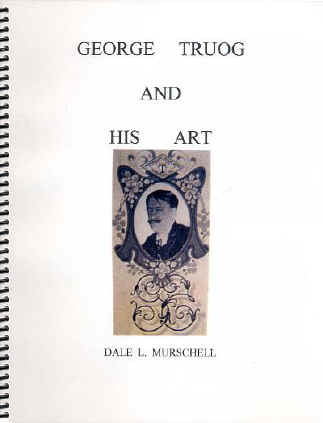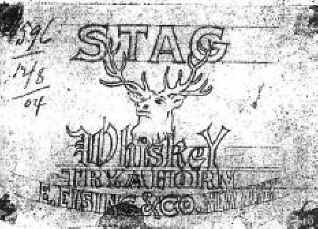 |
George Truog and
His Art by Dale Murschell Soft cover: 150 pages
|
Dale Murschell has long championed the talents of the old Cumberland glassmakers, and none more so than George Truog. A brief history of Truog's company, the Maryland Glass Etching Works of Cumberland, Maryland, can be found in Murschell's first book, Glass of Cumberland Maryland Area, published in 2002. This new book, George Truog and His Art, focuses exclusively on Truog and thereby plugs an sizable gap in our knowledge of pre-pro glass design and manufacture.
Most shot collectors should be familiar with Truog's work since he designed the labels for a number of shot and beer glasses. Take a look at some of his novelty items in the database for some outstanding examples. The 150 spiral-bound pages of George Truog and His Art are crammed with historical information and original sketchings.
Murschell begins with an overview that tells us of Truog's arrival in this country and his establishment of the Maryland Glass Etching Works. He also provides a historical timeline that traces the artist's fortunes from employee at the Central Glass Works to his ultimate ruin and demise.
The next chapter focuses on Truog's lavish home that was constructed to showcase his artist sensibilities and talents. The house fell into disrepair following service as a funeral home, but is currently being restored to its previous grandeur by new owners. The full-color photos provide an excellent sense of how the house must have looked at the height of Truog's success.
The following chapter brings together floor plans, letterheads and advertising materials from Truog's company, the Maryland Glass Etching Works. While the layout is choppy, the history is interesting.
The next chapter is where the fun begins because it features page after page of examples of Truog's work. Murschell photographed countless glasses from his own collection and also from other collectors in the Cumberland area. Many glasses will be familiar from watching shot-glass auctions close on eBay, but there are also Truog-designed bowls, vases, tumblers and jugs. There's also a section that helps a collector find and identify Truog signatures on glass.
Many of the same designs appear in the next chapter, but this time they're seen on metal etching plates. These are actual production plates used in the manufacture of the etched glass. Only two are known to survive but they provide important verification that some designs suspected to be Truog were indeed his work.
The final two chapters are what make this book well worth its purchase price, because they bring us 70-odd pages of original Truog sketches. The images in the first of the two chapters are culled from a scrapbook that is held by the Allegany College library in Cumberland. I've visited and examined this Truog grail myself. The library makes a microfilm record of the scrapbook available for collectors to print off copies, but the quality of the microfilm is very poor. The images reproduced in George Truog and His Art are as perfect as the originals and are a fascinating glimpse into the design process. Many, if not all, of the designs made it into production and can be found on glasses on this website.
The final chapter brings to light previously unpublished sketches made in pencil on tissue paper, taken from a scrapbook in the collection of Naomi Himmelright. The copy quality is poor, but this detracts little from the significance of the designs because it reveals the true scope of Truog's work. I always had a hunch that the "When You Do Drink" glasses were his and this chapter confirms it. But there are many other familiar glasses revealed to be original Truog designs: the "Stag Whiskey" below is only one of several such surprises (2024 update: The original Truog design can be found on this glass in the database).
 |
 |
| Truog design from "George Truog and His Art" | .....and a later version of the same glass from the database |
This book is well worth adding to your reference collection and will both please the eye and give you a new appreciation for Truog and his work. Plus it boosts the appraisal value of many a glass in your collection.